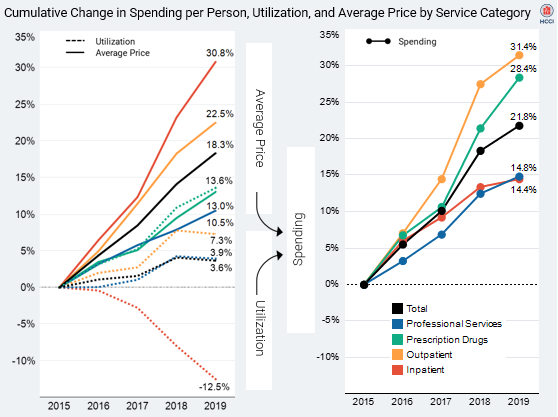by MATTHEW HOLT
So to celebrate 20 years, we’ll be publishing a few classics for the next week or so. This is one of my faves from the early days of THCB, back in 2006. It’s interesting to compare it with Jeff Goldsmith’s NEW piece from yesterday on vertical integration because at the time a pair of Harvard professors, Michael Porter and Elizabeth Teisberg were telling hospitals to change their operations in a way that seemed to me were going to destroy their business–cut down to one or two service lines they were best at and stop with the rest. McKinsey picked up on this and I went to town on why they were all wrong. In fact in the next decade and a half, despite all the fuss and consulting fees generated, almost no hospital system did anything other than merge horizontally with local competitors, stick up its prices, and buy feeder systems of primary care doctors or ally with/bribe specialists to keep their procedural referrals up. The result is the huge regional oligopolies that we have now. Despite all the ignoring of their advice, I don’t think Porter/Teisberg or McKinsey went broke in that same period.–Matthew Holt
McKinsey, an organization that prides itself on increasing the amount of consulting dollars it gets paid by improving the strategic direction of American business is making another foray into health care.
You may recall their last study on CDHPs was roundly criticized (see Tom Hillard for a good example including a hilarious and brutal smackdown of their research methodology in the last couple of paras), and this time they cleverly aren’t bothering with data—in fact they’re basically copying Porter and Teisberg. The piece, by Kurt Grote, Edward Levine and Paul Mango, is about hospitals and how they need to get into the 21st century.
And of course the idea is that hospitals need to change their business approach. Well, given that I hadn’t noticed a rash of hospital closings and the the industry as a whole has been growing its revenues pretty successfully over the years, what exactly are the problems?
The rise of employer-sponsored insurance in the 1930s and 1940s, and the emergence of government-sponsored insurance in the 1960s all insulated hospitals from the need to compete for patients. Today hospitals are “price takers” for nearly 50 percent of their revenues, which is subject to the political whims of the federal and state governments. Hospitals are also required to see, evaluate, and treat virtually any patient who shows up, solvent or not. Furthermore, physicians were productive because hospitals put a great deal of capital at their disposal. Yet these hospitals didn’t enforce standardized and efficient approaches to the delivery of care. At many hospitals today, doctors still bear only limited economic
responsibility for the care decisions they make. Little wonder that it is often they who introduce expensive—and sometimes excessive—nonreimbursable technologies or that hospitals not only suffer from declining margins but are also performing less well than other players in the health care value chain
The piece then has a pretty incomprehensible chart that compares the EBITDA (profit) of hospitals compared to drug companies and insurers. Surprisingly enough they make a whole lot less EBITDA than those businesses–although long time THCB readers will know we’ve been well down that path. And apparently their margins got worse and then better (from 25% in 1990 to 15% in 1995 to 10% in 2000 but back up to 15% in 2004).
McKinsey’s answer, basically filched from Porter/Teisberg, is for hospitals to specialize in particular service lines, stop being generalists and start trying to please the consumer who’ll be choosing among them. As a general mantra, this might be good for consultants to stick up on Powerpoint, but to be nice it’s massively oversimplified, and to be nasty it’s just plain wrong for most hospitals for the current and foreseeable medium-term future.
Their analysis ignores the fact that there are (at least) three broad categories of hospitals–inner city and rural safety-net providers, big academic medical centers, and suburban community hospitals. Each of these has a completely different audience, completely different set of incentives, and more to McKinsey’s point, different profit margins.
Right up front they talk about the 50% of revenue that comes from the government–but for the first two categories, it’s more than that! And for everyone, as public programs grow, it’s going to be increasing.
Those hospitals relying on Medicare make most of their money but playing very careful attention to the DRG mix. The ones who play that game well and make most profit on Medicare outliers (like the for-profits McKinsey features in its metrics) don’t really want to change that by stopping their patients becoming those outliers, because if they get better at treating patients, they make less money. Brent James’ famous Intermountain story tells the truth, and until Medicare really changes the way it pays, you don’t want to be ahead of that curve. Intermountain may have spent more than 10 years leaving money on the table, but those rich Mormons can afford it.
Meanwhile, for the mainstream community hospitals, as more and more services and patients leave the building, the imperative is not to change their business model, it’s to get their hands on that revenue that’s leaving with them. That’s why most big hospitals are now-co-investing with physicians in specialty hospitals et al. But while that’s a defensive battle to build better “hotels” for the star surgeons, it’s still about building better “hotels”–not junking the model of being the nicest possible host to the big time admitting surgeons.
The McKinsey/Porter/Teisberg theory is of course that if you get good at one service line, you’ll be attractive to consumers, and that they’ll choose you. There is more truth to this notion now than there was five years ago, but not much more. Doctors choose hospitals for their patients. That’s always been the case, other for those that get admitted via the ED, and that’s a function of location. That’s why hospitals suck up to surgeons. But even when consumers make choices, they’re not very active consumers beyond the deductible, and basically all hospital spending is beyond the deductible, and even in the cash non-hospital business (the stuff like genetic testing) most consumers take their doctor’s advice.
Which leads of course to who the other real consumer for the hospital is, and that’s the third party payer. First rule of dealing with payers is to figure out how to play the Medicare system well enough that you make it very profitable, but not too “well” that you get busted, a la Columbia/HCA, Tenet & St Barnabas.
Second rule is that you need to get bargaining strength against the health plans. No one can pretend that health plans really care in a global sense about having their providers cut costs and improve care delivery. They may say they care about it, but health plans add a chunk on the top of what they pay providers and stick that to their clients (usually employers) — who basically take it in a mealy mouthed way.
There is, though, a fight in any local market about where to draw the line on hospital pricing. But this fight is not about having providers from outside (or even within) the region swooping in to capture all a payer’s business with better pricing on certain service lines, and payers moving patients to these disease-specific treatment centers. Well, it is about that in the McKinsey/Porter/Teisberg fantasy land, but in reality the fight is about setting global pricing for all the services a payer needs for its members in that region.
Continue reading…

















